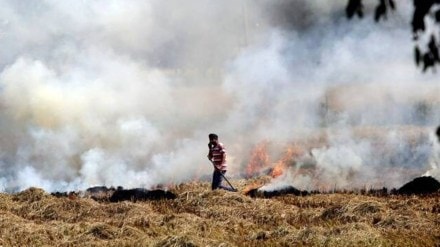Punjab, the biggest contributor to the stubble burning events in north India, aims to stop the farm practices in the next couple of years, with a sharp fall in paddy straw fire events reported this year, a senior official with Punjab Pollution Control Board (PPCB) said.
“We have initiated series of measures such as crop residue management in the soil, financial incentives to farmers, setting up biomass power plants to use the stubble and crop diversification and aim is to stop the practices of paddy stubble burning in the next two to three years,” Adarsh Pal Vij, Chairman, Punjab Pollution Control Board, told FE.
Vij said that with more than half of the paddy harvesting in the state completed so far, stubble fire events will likely be much lower than previous year.
During September 15 – October 31, 2023, Punjab reported a 52% decline in stubble burning events at 7673 compared to previous year, as per data by the Consortium of Research on Agro-ecosystem Monitoring and Modelling from Space, Indian Agricultural Research Institute, Delhi.
During September 15 – November 30, 2022, Punjab reported a 30% decline in stubble burning events at 49,922 compared to the same period in 2021. Punjab had a share of 72% of total reports of paddy straw burning in northern India.
During September 15 – November 30, 2022, there was a decline of 25% in stubble burning events at 69,615 across Punjab, Haryana, Uttar Pradesh, Delhi, Rajasthan and Madhya Pradesh compared to 2021.
An agriculture ministry said that stubble burning incidents usually peaks during October 26-November 6 in the northern states as farmers clear the paddy field for preparing the field for the wheat sowing in the rabi season.
As per the action plan by Punjab for this year, out of 3.1 million hectare (mh) of paddy area, the straw generation is likely to be around 20 million tonne (MT).
Out of these 16 MT of straw is generated from non-basmati rice crop which is not suitable for fodder use because of higher silica content that animals can’t digest.
Vij said that 11.5 MT of paddy this is year being treated under ‘in-situ’ management (on field treatment through compost to boost soil health) and about 3.47 MT of paddy straw through ex-situ management (straw used for power generation and industrial use in paper, sugar and biogas plants).
Meanwhile, under the the Confederation of Indian Industry’s cleaner air better life initiative , 62,000 farmers in Punjab are encouraged to do mulching, straw incorporation, and baling of paddy straw, which has resulted in prevention of straw burning in 0.48 million hectare this year.
Punjab has been focusing on the Ludhiana, Sangrur, Patiala and Barnala districts for encouraging farmers against paddy stubble farming through crop diversification.
The crop diversification would entail financial incentives to farmers, procurement of crops by state agencies at minimum support price rates and incentives for processing facilities. Annually, around 0.1-0.2 mh paddy sown will be shifted to alternate crops such as sugar, vegetables and cotton.
Meanwhile, incidents of stubble burning after paddy harvesting in Punjab, Haryana, Uttar Pradesh, Madhya Pradesh, Rajasthan and Delhi, since September 15, have declined by 31% to 13,645 till Tuesday compared to the same period last year.
All this augurs well for the air quality in the national capital region. The NCR Delhi air quality was in the “very poor” range on Wednesday, while at this peak time of stubble burning in the adjacent states, the NCR used to have still worse air quality at “severe” level.
